Species Spotlight: Top 10 salamanders of the Pacific Northwest
May 24, 2021
The Pacific Northwest is renowned for its natural beauty: cascading waterfalls, lush forests and– of course– its wildlife. Hidden among our vast and beautiful home is a creature of equal beauty and prowess: the salamander. Your long awaited sequel to “Top Ten Frog Species of the Pacific Northwest” has finally arrived, as today we look at the top ten salamanders found in and around Oregon.
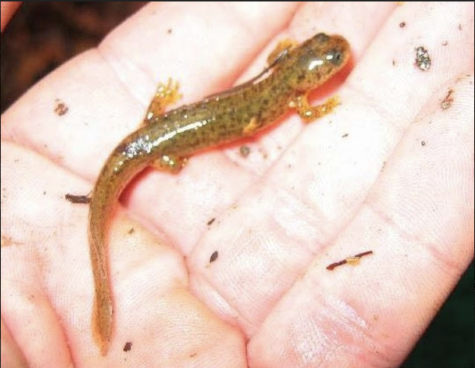
10. Southern Torrent Salamander
While at first glance this salamander may look like jello with eyes, it soon becomes clear that you can’t judge this book by its cover. The Southern Torrent Salamander is four to five inches in length, likes to spend its time in large, dense forests and can survive in much drier temperatures than most salamanders. Although this salamander has few traits that make it stand out from others, it makes up for it when factoring in how silly it looks.
9. Western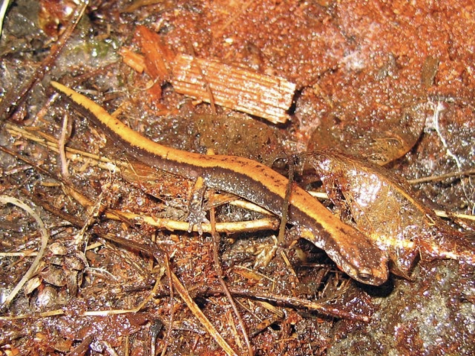 Red-Backed Salamander
Red-Backed Salamander
The Western Red-Backed Salamander is a small salamander that can usually be found in high elevations on rocky slopes. I am placing it on this list mostly because of how much I like its trademark feature: a giant racing stripe going down its back. In its essence, this salamander is like a smart car that got put in the “Fast and the Furious” franchise. Not super interesting, but saved by a cool paint job. The Western Red-Backed Salamander also breathes through its skin because it doesn’t have lungs which is a little bonus that earned it the number nine spot. Overall, this is a fairly solid salamander
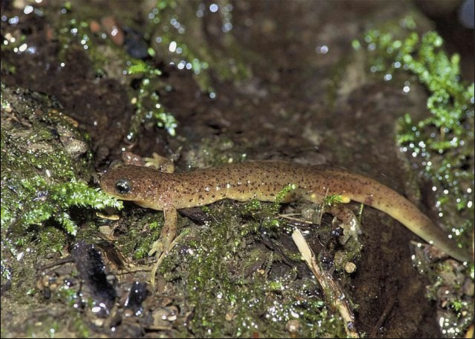
The Olympic Torrent Salamander is around three to four inches in length and has quite interesting habits. The only recorded sightings of these salamanders are in Olympic National Park or the Olympic mountain range in Washington. When startled, it rolls over to scare off its attacker with its bright yellow stomach. A big reason why I like this salamander so much is because of how it looks like a friendly dinosaur, while having a defense mechanism like a goat (though admittedly much funnier).

The Larch Mountain Salamander is the rarest addition to this list as it is highly endangered and very sedentary so to see one you really have to be looking for it. I’ve added it to this list for two key reasons. First, because it breathes through its skin due to not having lungs. While this is a common trait for salamanders, it will always get extra points with me because that’s very nifty. Second, because the Larch Mountain Salamander lives in lava fields or in and around natural debris. This salamander seems so unique in that it likes to hang out in places that don’t seem exceptionally livable at first glance.
When it comes to appearance, the Klamath Black Salamander is unlike any of the other salamanders on this list. They are dark as night with a slight sheen and sometimes white specks. It’s like somebody turned a mural of space into a salamander. This salamander also has no lungs and resides next to streams and rivers, which seems like a pretty chill way to spend your time. Overall, the Klamath Black Salamander’s appearance carries it to the sixth spot on this list, but isn’t what defines this unique species.
This salamander makes the list because I think it looks funny, and it has no
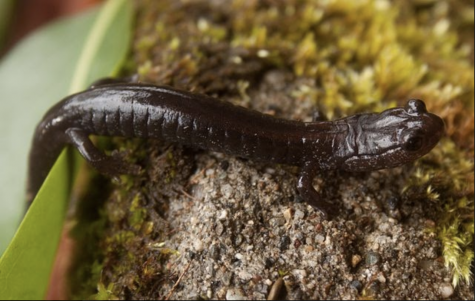 lungs. The Del Norte Salamander has trademark tiny legs, which are always a plus in my book. However, the most interesting thing about this salamander is that its body shape, color and facial features all come together to make it look like Randall Boggs from Monsters University (something that both amuses and haunts me).
lungs. The Del Norte Salamander has trademark tiny legs, which are always a plus in my book. However, the most interesting thing about this salamander is that its body shape, color and facial features all come together to make it look like Randall Boggs from Monsters University (something that both amuses and haunts me).
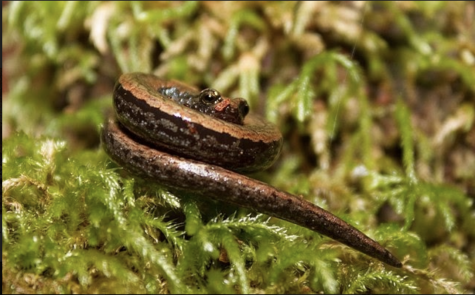 Oregon Slender Salamanders are quite intriguing. Like the Larch Mountain Salamander, they are found in lava fields, and their distinctive molten-esque skin patterns allow them to blend in quite well. They also have notably tiny legs, which is, again, a positive. When factoring in their lack of lungs, this salamander has definitively earned its place on this list.
Oregon Slender Salamanders are quite intriguing. Like the Larch Mountain Salamander, they are found in lava fields, and their distinctive molten-esque skin patterns allow them to blend in quite well. They also have notably tiny legs, which is, again, a positive. When factoring in their lack of lungs, this salamander has definitively earned its place on this list.
The Clouded Salamander is, and I mean this in the most endearing way possible, the devil’s
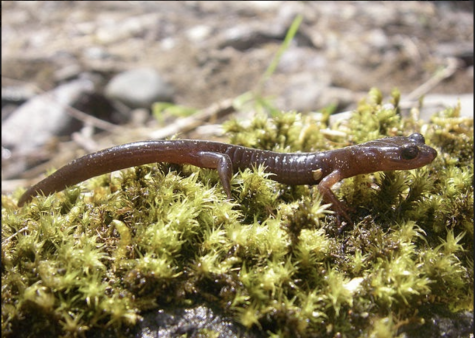
pet salamander. They are an ashygrey, have long skinny legs and find their home in decaying or burned down forests. Now don’t get me wrong at all, this is absolutely fantastic. These guys found the most hardcore way to live their lives and went for it, which I have the utmost respect for. Very cool salamander.
To preface this specific addition to the list: I understand that this is a newt and not a salamander, but I’ve added it on the grounds that the difference between the two is so small, and that I think this newt is beyond cool. (This is also my list so there’s nothing you can do about it.)
At five to six inches in length, the Rough-skinned Newt easily makes the top three on this list due to how cool it looks and how dangerous it is. First of all, its skin is super
 interesting, the epitome of design. This newt’s rough skin makes this animal look both cute and super tough. On top of that, their skin releases toxic venom known as tetrodotoxin (TTX)that can kill most of the newt’s predators, making the Rough Skinned Newt’s appearance the epitome of both fashion and function. In fact, in 1979, a man died after eating a Rough-skinned Newt, which is irrefutably history’s most prime example of asserting dominance. The only known animal to have built up a resistance to their venom is a Garter Snake, but even that doesn’t have a 100% guaranteed success rate. The beast that is the Rough-skinned Newt can’t be stopped, and I, for one, support it fully.
interesting, the epitome of design. This newt’s rough skin makes this animal look both cute and super tough. On top of that, their skin releases toxic venom known as tetrodotoxin (TTX)that can kill most of the newt’s predators, making the Rough Skinned Newt’s appearance the epitome of both fashion and function. In fact, in 1979, a man died after eating a Rough-skinned Newt, which is irrefutably history’s most prime example of asserting dominance. The only known animal to have built up a resistance to their venom is a Garter Snake, but even that doesn’t have a 100% guaranteed success rate. The beast that is the Rough-skinned Newt can’t be stopped, and I, for one, support it fully.
The Ensatina Salamander is both aesthetically pleasing and dangerous, easily skyrocketing it to the top of this list. This salamander can grow up to around three inches long, and kind of looks like a tiny dragon with its bright, scaly body and large, keen eyes. The Ensatina’s long tail both adds to how cool it looks and serves as a weapon. When it feels threatened, this salamander secretes a toxic venom from its tail and slashes at its foes, which all together makes this salamander a cool looking swordsman that can fit in the palm of your hand.
 There should be a couple things you take away from this review. The first is that salamanders are really amazing and deserve the utmost praise.
There should be a couple things you take away from this review. The first is that salamanders are really amazing and deserve the utmost praise.
The second is that there are tons of salamanders in the Pacific Northwest, and this list is nowhere near encompassing all of those different species. They could be either miles away or in your own backyard, but the most important thing to remember is that it doesn’t matter which ones you find, just that you go out and find them. Who knows what you might find (but hopefully it’s a cool salamander)!

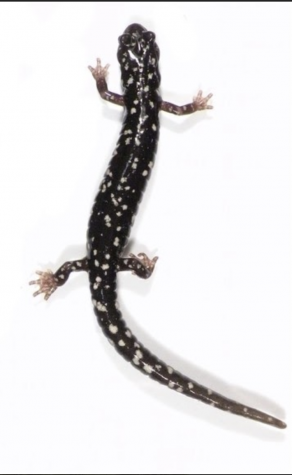 Salamander
Salamander


Western Axolotl • May 29, 2021 at 3:03 pm
Great stuff here! I think your top two are perfect— always a fan of both those guys. As I see it, newts are a type of salamander, just like toads are a type of frog, so you are in the clear there. I think I would have put the Black at #3 ahead of thrme slender guy, just because they are so cool. Great list and great writing!
Mathilda • May 27, 2021 at 8:55 pm
Hi there lol. I request u to write a formal document on the different species of fish located in the pacific nw. That or moose.
Julian • May 25, 2021 at 11:52 am
This is by far the most interesting thing I have read all week! I look forward to seeing another amazing article by the great Owen Adams.
Soren Westrey • May 25, 2021 at 10:50 am
I think the Larch Mountain salamander is my favorite. It is so babby. Also larches are my favorite tree.